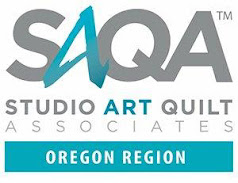Our speaker for the November meeting was CFA Guild Jennifer Ayotte. She is an LBCC Community Education teacher. Her presentation, "Sketching with Fabric and Thread" described her textile journey and how she came to her process of creating hand-stitched fabric sketches. We were delighted with the many examples of her work. She shared her preferred types of threads and the types of backing fabrics, as well as some of her favorite mounting techniques.
Thursday, November 13, 2025
Guild meeting on Tuesday, Novmeber 11 2025
Thursday, October 16, 2025
Guild meeting on Tuesday, October 14, 2025
Our beautiful fall weather brought a full house for our guild meeting. The program was presented by member Jennifer Lommers. She shared her experience at Playa Summer Lake's 10-day workshop, taught by artist and poet Daniela Naomi Molnar. The workshop focused on exploring pigment, ink and dye making methods using rocks and botanicals gathered on location. We were informed about observing reciprocal foraging practices when we use materials from our lands. It was an inspiring presentation.
Thursday, September 11, 2025
Guild meeting on Tuesday, September 9, 2025
We had a full house at our first meeting of fall. Members were eager to gather and share our love of fiber arts. There was a cyber glitch in members' receiving the agenda and newsletter, so many were not aware of the planned program. We were to bring a textile, apparel item or accessory that had special meaning to us and share its story with the group. Members who knew about the program brought items and shared their stories. Below are a few photos.

Wednesday, June 11, 2025
June 10 CFA guild meeting
On June 10th guild members gathered for the final meeting of this season. We will resume meeting on September 9th.
Our program focused on viewing the Studio Art Quilt Associates, Oregon Regional Group's trunk show, Common Threads: The Stitches that Unite Us. Here is a little information about the Oregon Regional group of SAQA:
SAQA is dedicated to promoting the art quilt and the artists who create them. Whether you're an artist, a collector, or enthusiast, we can offer you inspiration and resources to support your passion for art quilts. Join our dynamic creative community and help make the art quilt universally recognized as a fine art medium!
More information can be found at https://https://www.saqa.com.
For tonight's program, four members gathered at each table, studying 5 of the little 7" by 10" quilts. After viewing each set of 5 quilts, the quilt set was passed to the next table, rotating until all members had viewed all 30 of the quilts. It was fascinating to read the descriptions of the materials and techniques the artists used to create the quilts. The trunk show also included 5 of the SAQA Global Exhibition catalogs containing the work of themed international juried exhibitions. Catalogs of the global exhibitions can be purchased at https://www.saqa.com/online-store
Friday, May 23, 2025
May 17th Workshop by Jane Pearlmutter
CFA Guild member Jane Pearlmutter presented the first session of a two-part workshop that focused on stitching family stories and memory cloths on vintage textiles.
Jane showed examples of some of her textile pieces while taking about process, supplies and materials.
Thursday, May 15, 2025
May 13th guild meeting
CFA Guild member Mariana Mace presented a slide presentation of textile treasures of Uzbekistan and Tajikistan. She traveled with a local embroidery expert who also works with rural women who are textile entrepreneurs. The tour included meetings and master classes with a broad group of traditional artists and artisans. We were enthralled.
Wednesday, April 9, 2025
April 8 Guild meeting with Karen Miller
This evening's meeting was presented by guild member Karen Miller. who shared her thirty years of study and practice of katazone. She talked about the history and design of the paper stencils used in this fascinating Japanese craft. We learned about how the stencils are used to create repeating patterns printed onto yardage. We saw examples of vintage stencils and many of her delicate and intricate hand cut stencils featuring the theme of our natural world.
The photo below shows an example of a textile printed from a hand cut stencil. Karen talked about how stripes can be used to create amazing visual imagery.













































